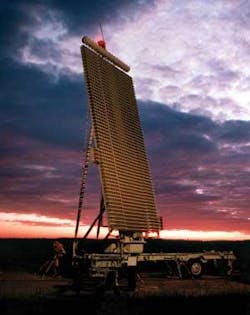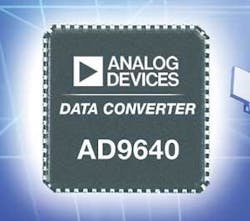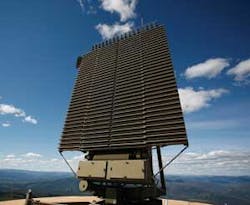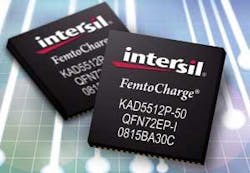Analog-to-digital converter and digital-to-analog converter designers struggle to keep pace with an RF spectrum burdened with wireless PDA users, broadband Internet surfers, traditional radio communications–and an enemy that detonates roadside bombs with cell phones and garage door openers.
By John Keller
Modern electronic equipment for military and aerospace applications presents systems designers with a fundamental contradiction: the real world we observe with electronic and electro-optical sensors is analog, yet the way we process sensor information is digital. There has to be a fast, efficient, and accurate way to translate analog sensor information into digital data for efficient processing, and to translate digital data back to analog for wireless transmission and–let’s face it–for human understanding.
Enter the modern analog-to-digital (A-D) and digital-to-analog (D-A) converters. These devices, designed and integrated by a handful of industry specialists, represent the crucial glue that links the analog world to the digital. Without them, much of today’s high-performance digital processors would be useless in RF and electro-optical applications like radar, software-defined radio, electronic warfare, missile guidance, high-end test and measurement equipment, and counter improvised explosive device (IED) systems.
Instead, systems designers would have to rely on complex and expensive analog data processors, and most likely would render information not as quickly and accurately as do today’s systems that use modern A-D and D-A converters. With the plethora of widely available, high-performance, and relatively inexpensive digital processing available today, such as multiprocessing embedded computers and field-programmable gate arrays (FPGAs), the value of the A-D converter cannot be understated.
“Typically the A-D converter (ADC) is selected first, and then the [digital] signal processing path behind the ADC; it’s one of the long poles in the tent,” explains Phil Lopresti, director of the high-speed data converter products at A-D converter manufacturer Intersil Corp. in Austin, Texas. The A-D and D-A converter “really defines the overall system capability and system limits,” adds Mike Althar, vice president and general manager of the Intersil Special Products segment in Palm Bay, Fla.
As designers use the A-D and D-A converters as bridges between analog and digital data, they also must balance the amount of processing necessary for each realm. “It is always a compromise in the processing you do in the analog part of the world, and processing you do once the data becomes digital,” says Andrew Reddig, president and chief technology officer at TEK Microsystems Inc., a high-performance signal processing specialist in Chelmsford, Mass. “It’s easy to do lots of manipulations once you get a signal into the digital realm,” Reddig explains. “Analog processing is complicated and very expensive.”
One goal of systems integrators is to place the A-D converter as close as possible to the sensor gathering the analog signal–typically an antenna or electro-optical sensor. In this way, they can simplify their architectures and do the maximum amount of processing digitally, which is fast and inexpensive.
Performance in balance
A-D and D-A converters essentially have four crucial benchmarks that enable manufacturers and users to characterize their performance for different kinds of applications:
- ) speed, or bandwidth, as measured in MHz or megasamples per second (the larger the number of megasamples per second, the faster the device);
- ) resolution, or accuracy, as measured in bits (the larger the number of bits, the higher the resolution of the device);
- ) noise and distortion rejection, as measured in decibels, or dB (the higher the decibel level, the better the device rejects noise and distortion); and
- ) size, weight, and power consumption.
The speed of the A-D and D-A converter describes how many signal samples per second the device can process. Typically this is measured in MHz, or millions samples per second. Some devices can take only hundreds of samples per second, and some of today’s fastest devices can take 3 billion samples per second (gigasamples).
The resolution of A-D and D-A converters refers to the detail and depth of each sample taken, and is measured in bits. The higher the number of bits, the more detailed is each sample taken. High resolution is particularly important in applications like imaging radar that must discern small objects close by large objects, or in signals intelligence that must be able to characterize even the faintest radio signals in the presence of many other signals and electronic noise.
Noise and distortion rejection is measured in two ways. The first is spurious noise dynamic range (SNDR), and the second is signal-to-noise ratio (SNR), both of which are measured in decibels, or dB. The higher the dB level of these two measurements, the better the A-D or D-A is at detecting and characterizing weak signals that may be important. Strong noise and distortion rejection is particularly important for applications like signals intelligence, radio communications, or sophisticated radar jammers.
Some A-D and D-A makers will list a device’s “useful bits” rating for resolution, which considers not only the part’s resolution, but also its noise and distortion rejection ability. An A-D or D-A may have a high bit resolution rating, but poor noise rejection, which effectively would reduce its useful resolution bits rating.
Size, weight, and power consumption–collectively referred to as SWaP–are particularly important for portable and handheld applications such as handheld software-defined radios and portable spectrum analyzer gear for deployed electronic warfare and IED detection, as well as for fighter aircraft, unmanned vehicles, and missile applications.
Different devices, different applications
Relatively large ground-based or shipboard radar applications, for example, do not depend so much on SWAP because they have ample power supplies and space. Conservative power consumption can be a factor in these kinds of applications, however, to reduce heat and the need for exotic electronics cooling schemes.
“If it is part of a ship or vehicle, there are relatively few power constraints,” explains Chuck Sanna, product marketing engineer for A-D and D-A converter manufacturer Texas Instruments Inc. (TI) in Dallas. “With portable devices, the battery is the issue.”
The larger the application, the more the designer concentrates on pure A-D and D-A converter performance, rather than on device size and power consumption, says Pam Aparo, marketing manager for device maker Analog Devices High-Speed ADC Products segment in Greensboro, N.C. “Most of the requirements we get break down into ‘the sky’s the limit’ in the performance and power that our users need,” she says. “A ground-based radar is not concerned about power; they want all the performance they can get. With missiles and communications and things people have to carry, it has to be a lightweight system, so we have to get the size and power down.”
Something else systems integrators must consider when looking at A-D and D-A converters is the analog circuitry in the processing chain immediately before the converter. If these components are of marginal quality, it might not make sense to use a top-of-the-line signal converter.
“It’s not just the ADC that you have to think about in terms of a system,” explains Duncan Bosworth, director of engineering at TEK Micro. “There are still the analog components that go into the front of it. ADCs aren’t fast enough yet to see everything, so you still need to think of the ADC along with the receiver you use with it. There’s no sense to have an ADC with deep resolution if your amplifier and receiver have very poor noise performance. The analog part will dominate overall performance.
“A-D is the boundary between analog and digital, but it is very important to match the tuner and amplifier stage with the A-D state so that everything works together as a system,” Bosworth says.
TI’s Sanna says A-D and D-A converter makers must consider three potential system bottlenecks: how good is the analog front end that interfaces with the antenna; the digital processing behind the A-D and D-A converters; and the converters themselves, which occasionally can introduce noise, distortion, or other unwanted artifacts to signals of interest.
Design tradeoffs
No A-D or D-A converter–at least not yet–can be all things to all people. One rule of thumb is the faster the device, the lower its resolution and noise rejection. On the other hand, the devices with the finest resolution and noise rejection typically are not the fastest devices. It all depends on the application and the designer’s needs.
One kind of radar jammer, for example, might have a high priority on speed, at the expense of resolution. Above all, this system may need to detect radar signals quickly so it wastes no time in overwhelming the enemy signal with jamming energy. In this application, it is not so important to characterize the radar signal with fine resolution as it is to detect the radar signal quickly and jam it.
Signals intelligence and radio communications, on the other hand, put a priority on high resolution to detect and classify weak signals of interest–particularly when the desired signals are alongside strong signals or strong sources of noise.
Airport security screening systems also put a priority on signal conversion resolution over speed. These X-ray systems and gas sniffers “are detecting everything from explosives and contaminants, and the higher-precision converters help with the swabbing and puffers,” says Intersil’s Althar. “Better resolution gets you to lower parts-per-million levels.”
In noise and distortion rejection, designers sometimes would like to choose between optimizing for SFDR or SNR. A-D and D-A specialist Analog Devices Inc. in Norwood, Mass., offers the AD 9268 A-D converter that has a dither switch to enable users to choose between optimizing for SFDR and SNR. “It lets the users decide if they want low noise or better spurious performance,” says TI’s Aparo.
State of the art
Users of the devices constantly push the manufacturers to improve all aspects of A-D and D-A converters. “Customers want everything–more speed, more resolution, lower power consumption, and smaller size,” says TI’s Sanna. “As the military really gears up the communications network side, the main driver is increased need for lower power. A cell phone on steroids type of system drives a lot of it across the board, and the digital battlefield is a huge driver.”
A-D converter Nirvana for systems integrators has not materialized yet, but manufacturers are edging ever closer to what might be considered the perfect device. “We asked one of our customers recently what they want in a perfect world,” says TEK Micro’s Reddig. “They said take all of the RF [device speed] up to 18 GHz and digitize with enough bits so that everything is digital, and you don’t need a tuner or processing at the analog end. A-Ds don’t do that yet.”
Still, much progress is being made. Historically, at a given resolution, A-D and D-A converter designers have been able effectively to double the sampling rate of their devices without hurting SNR or SFDR every one to three years, says TI’s Sanna. “You can do a lot if you throw power at it,” he says.
So what is the state of the art in today’s A-D converters? It all depends on the device’s optimization for speed or resolution.
At Texas Instruments, for example, the highest-resolution device–at 16 bits–tops out in speed at 200 megasamples per second, Sanna says. The company’s best 14-bit device runs at 400 megasamples per second, the 12-bit device runs at 550 megasamples per second, the 10-bit device runs at 2 gigasamples per second, and TI’s best 8-bit A-D converter runs at a dizzying 3 gigasamples per second, or even faster.
At Intersil, the state of the art is in the realm of 12 bits of resolution at a speed of 250 to 500 megasamples per second. The company’s best 14-bit A-D converter runs at 250 megasamples per second. Intersil’s flagship product–the KAD 5512 P-50, is a 12-bit A-D converter running at 500 megasamples per second, with signal to noise ratio of 66 dB and an SFDR or 85 db. Users can push this device to speeds of 1.3 GHz, says Intersil’s Lopresti.
At Analog Devices, the best is yet to come, with anticipated new A-D converter introductions in January and April 2010. These devices will have resolutions in excess of 14 bits, speeds faster than 150 megasamples per second, and be optimized for SFDR, which should be in the mid-90s dB, Aparo says.
“The big leap in both of those products will be much higher linearity at wider sample rates than we have available today,” Aparo says. “They will have much better spurious dynamic range, and will be for use in applications like a radar system to make sure you are not seeing false targets, and to see small targets next to large targets. In communications, it helps avoid interference from other channels.”
Design trends
One of the most noticeable design trends in A-D and D-A converters is reducing size, weight, and power consumption for applications like handheld radios and sensor packages on unmanned aerial vehicles.
“We are seeing radical improvements in power consumption,” says Intersil’s Lopresti. “People are trying to move that kind of data acquisition technology into mobile devices, handhelds, trucks, and movable equipment.”
Among the approaches manufacturers are using to shrink A-D and D-A converter geometries is to increase their use of on-board digital processing to enhance functionality, reduce device size, and cut power consumption. “Smaller geometries help with power significantly,” says Analog Devices’ Aparo. “We use more digital processing on the device so as not to make it hopelessly large.”
Designers also are fabricating chips with several A-D or D-A converters on board. “Now our A-D converters are in 12-bit resolution and are moving into duals, quads, and potentially octals in channels on the same chip,” says Intersil’s Lopresti. “In the past, you bought one 12-bit ADC, and now you can buy four to eight on the same chip.”
One way manufacturers seek to reduce size, cut power consumption, and increase performance is through a controversial approach called interleaving. This enables devices to work together to speed signal sampling–much the same way that multiprocessing computers use several microprocessors working together to increase computational speed.
A-D converter manufacturers like National Semiconductor in Santa Clara, Calif., Intersil, and others are pursuing interleaving technology, while others around the industry do not give this design approach much credence. “People have tried ganging A-Ds together,” says Rodger Hosking, vice president of signals intelligence and software-defined radio processing specialist Pentek Inc. in Upper Saddle River, N.J. “In practice it is very difficult, and almost never works very well.”
Nevertheless, Intersil’s Lopresti says A-D converter interleaving is an important part of his company’s strategy. “We do, in fact, have IP that allows us to interleave these converters together, and that is how we create very-high-performance, lower-power ADCs–by interleaving two ADCs on the same chip.”
It’s not easy however, yet the rewards can be great. “The only real tradeoffs you have to contend with are you must have a very area-efficient core,” Lopresti says. “You will probably need to use bipolar or BiCMOS to do that. The device must be very area efficient, and you have to embed some kind of digital logic to identify the interleave spurs, and then identify the corrections needed in an algorithm to eliminate those spurs.”
Future applications drivers
The landscape for A-D and D-A converter manufacturers isn’t getting any easier. Not only are systems integrators always asking for more capability, but the environment in which these devices must operate also is becoming more complex and difficult.
One of the most pressing issues is crowding in the RF spectrum. The recent federally mandated digitization of commercial over-the-air television signals has opened many frequencies to new users, such as cell phone operators, wireless networking, and more.
“In signals intelligence, they are being inundated from signals from everywhere–laptops on Wi-Fi network hot spots, an explosion in cell phone technology with video, text, Internet surfing, and e-mail browsing,” says Pentek’s Hosking. “And in a war you have people setting off explosives with cell phones, and you have traditional battlefield communications that need to maintained, secured, and fault tolerant. This leads to higher demands of signal-to-noise performance so you can get the job done better than before.”







